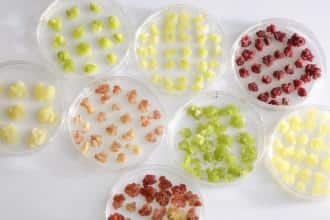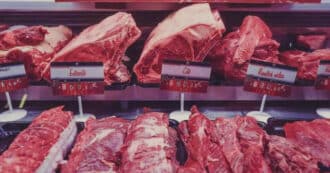By Jordan Rindler – Cellular Agriculture is the process of replicating naturally occurring cellular tissues (which are groups of similar cells that work together to serve a function) in a controlled, growth-oriented environment. Animal cells are programmed to replicate, which causes the organism to grow.
Cellular Agriculture uses the replication instructions that are coded in animal DNA and isolates the specific desired tissue. A nutrient-rich serum called growth media provides all of the necessary nutrients for the tissue to grow in a controlled environment.
To grow a chicken breast, a small initial culture of cells is harvested from, you guessed it, a chicken breast. This serves as the base for cellular cultivation. These cells don’t know that they are not in fact inside of a chicken anymore.
All the cells know how to do is create more chicken breast cells out of the nutrients that they receive. The growth media is then injected into the cells, supplying them with the necessary materials to follow their genetic code. This catalyzes the cell replication and the result will be a functionally identical chicken breast, grown from a microscopic culture of cells.
Industrial Agriculture is Destroying our Climate
Animal products have been an enormous source of nutrition and utility even before humans learned the art of domestication. Our prehistoric ancestors used the meat of a hunted animal to feed their tribe, its hide to keep warm in the winter and create shelter, and its bones for tools, weapons, and jewelry.
Today, industrial agriculture and factory farming have transformed the way we consume animal-derived products and turned animal agriculture into an extremely destructive industry in respect to green house gas emissions and thus the climate.
Agricultural Carbon Emissions are Rapidly Warming up the Earth
The animal agricultural sector is responsible for 18% of all anthropogenic greenhouse gas emissions (GHG), which is more than all cars, trains, and planes combined, and that is without even considering food transportation, packaging, and waste. The entire global food sector is responsible for 32% of GHG emissions and 37% of all methane emissions, which traps 26 times more radiation in the atmosphere than carbon dioxide.
Cellular agriculture has the incredible potential to reduce land and water use by up to 99% and greenhouse gas emissions by 96% per kilogram of animal product by cultivating biologically identical organic tissues without needing to raise, feed, and slaughter the animal. Instead of having to feed a calf until maturity, which takes an enormous amount of food, water, and energy proportional to the total product that the cow will create in its lifetime, we can grow beef, synthesize milk, and engineer genuine leather, all in a lab.
If cellular agriculture can be scaled to produce meat in a sustainable and ethical way, the potential for reducing land use could not only help address agricultural emissions but also reduce deforestation, which is another significant source of GHG emissions.
Let them Eat Cellular Meat!
One of the biggest climate resistance points we are facing, especially in the western world, is the mass refusal to adopt sustainable eating habits. The vegan and vegetarian diets have seen a substantial increase in popularity especially in the last decade, but the large majority of the population still have no intention of cutting down on meat.
Cellular agriculture can reconcile the cultural rejection of plant-based protein with the absolute necessity to significantly cut agricultural carbon emissions through lab grown meat that is indistinguishable from its traditional livestock counterpart.
Cool Concept, but is Cellular Agriculture a Viable Alternative to Farms?
Currently, the world is still skeptical, with good reason. The concept of cellular agriculture is so abstract and counterintuitive; creating an egg without a chicken and a chicken without an egg makes the question of which came first even more confusing. As the technology progresses and becomes more integrated into the mainstream, skeptics will have their doubts refuted by a perfect burger, porkchop, or filet that comes straight from a lab.
When Ford invented the modern automobile, the leaders of the horse industry laughed at him and asked why anyone would pay an absurd price for a car that’s more dangerous, harder to fuel, and less practical than the trusty stallion that had been used without fail for thousands of years.
It wasn’t until the automobile industry began to scale up and integrate itself into society via infrastructure and legislation that the same horse dealers who mocked Ford began to realize that their own industry would soon be rendered obsolete.

So, How Far Along Is Cellular Agriculture?
Cellular agriculture is currently an infant industry with a lot more research and market testing needed before it can truly compete with traditional big agriculture on a global scale. However, we have seen incredible progress within the last 8 years.
In 2013, the first lab-grown burger was produced. This was an amazing scientific achievement with revolutionary potential, but absolutely obsolete as a long-term, sustainable alternative to traditional meat, because the burger cost a whopping 300,000 USD to grow.
Lab-Grown Ribeye, an Israeli Scientific Feat of Tissue Engineering
Israeli start-up, Aleph Farms, the first company to ever lab-grow a steak in 2018, uses a proprietary 3D bioprinting technology to specifically tailor the texture and nutritional content of their steaks. By adjusting the collagen to fat tissue ratio, the company is able to create an incredibly wide variety of steaks that can mimic the different tastes and textures found in steaks today.
To grow a steak, layers of lean meat cells must be combined with connective tissue and intramuscular fats in addition to more complex proteins that must be arranged in a way that resembles the iconic “marbling” in a steak, which is a term used to describe the visible fat spread and content seen when looking at a high-quality steak.
Beef, and especially steaks, are the most expensive cellular agriculture products to produce due to the various amount of tissues needed to replicate the mouthfeel of a non-cultured steak. This is parallel to the cost of beef in traditional agriculture, which requires more than 10 times as many resources to produce in comparison to poultry, dairy, eggs, or pork.
Meat is much more challenging and resource-intensive to produce than a chicken breast, which has a smaller variety of protein and fats and therefore demands fewer cell cultures. Another Israeli company, Future Meat Technologies, has developed a different method for cellular agriculture and is pushing the limits of lab-grown cellular meat production.
On June 25th, 2021, Future Meat Technologies opened the world’s firsts synthetic meat production plant in Rehovot, a city outside Tel Aviv. This factory currently produces 500kg of cultured chicken, lamb, and pork, every day. This milestone happened many years ahead of what the market anticipated and proves that while cellular agriculture is still an industry of the future, the widespread adoption of cell-based meat is not as far beyond the horizon as we thought.
Beyond Agriculture: Materials and Medicine
This specific manipulation of cellular structures used to engineer steak can also be applied to other animal products such as milk, honey, and even non-food products. The production potential of animal products, via cellular agriculture, stretches beyond a more sustainable food source. Virtually any protein or tissue that is synthesized in an animal will soon be replicable with stem cells and gene-editing technologies.
Growing meat is just the beginning for cellular agriculture. Agricultural products like leather, silk, and even extremely rare materials like rhino horn and sturgeon caviar can all be lab-grown without animals using cell tissue engineering.
Will Cellular Production Lead to The End of Poaching?
The ability to create such rare and sought-after materials that are only found in endangered animals has the potential to effectively end the poaching industry by causing supply to skyrocket and therefore diminish demand.
With lower prices on the black market for illegal animal products like rhino horns, shark fins, or elephant tusks, poachers will not be able to keep up with the influx of completely identical cellular products. Eventually, they will be forced to end their senseless slaughtering because the money that goes into the poaching industry will dry up.
Antibiotics, Superbugs, and a Potential Cellular Solution
A commonly overlooked issue in industrial agriculture is the proliferation of antibiotic use on domesticated animals. Not only are these antibiotics expensive to research and produce, but there are also adverse effects from injecting billions of animals each year with these antibiotic concoctions.
Superbug refers to a bacterial disease that has evolved a resistance to our antibiotics. When we allow common bacteria to be perpetually exposed to these antibiotics, we are creating an environment where a random genetic mutation can create a strain of bacteria that we are helpless against. This is a fear that has inspired a movement against the use of mass antibiotics in agriculture, as the potential risk is too high to justify continuing this practice.
Luckily, cellular agriculture happens in a sterile environment completely absent of these bacteria, which makes the use of antibiotics in labs obsolete. This offers a solution and potential alternative in case of a catastrophic superbug breakout, so that a mass adoption of cellular agriculture can preemptively stop the threat before it even happens.
What’s the Future of Cellular Agriculture?
With the first cellular agriculture factory already open and bringing in revenue, there will now be market data to support or disprove the viability of cellular agriculture to be a long-term solution to the problems we are facing due to traditional agriculture.
We know that the concept and the science are absolutely solid, but the fastest way for an industry to grow is with the support of investors and venture capitalists. These entities will look past the scientific proof of concept and focus on the business proof of concept instead, which means that if cellular agriculture can’t become a profitable business then its adoption will be delayed until it can.
The future is looking extremely bright. Future Meat Technologies can already produce an entire chicken breast for under $4 USD, which is only slightly more expensive than the normal production cost. As the technology and business sides of this sector both continue to scale up, costs will continue to decrease.
By 2025 we could find ourselves eating synthetic meats at restaurants and at home on a regular basis. Jews, Muslims, and Hindus are already discussing how to understand cellular agriculture within their traditional religious restrictions around meat consumption. One thing is for sure, cellular agriculture is a more ethical, sustainable option and is poised to change our relationship with food production and the planet forever.
* Featured image source



